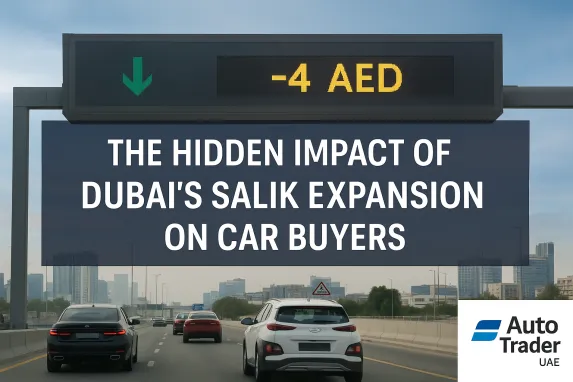The Hidden Impact of Dubai’s Salik Expansion on Car Buyers
Introduction
Dubai’s road network is world-class — but staying mobile in the city now comes with more to think about than just fuel or parking. With the latest Salik expansion and introduction of new toll gates across key routes, car buyers in the UAE are starting to feel an unexpected ripple effect.
From changing daily commute costs to influencing what type of car people buy, the Salik system is becoming a silent factor in every Dubai driver’s decision.
If you missed the updates, read:
Let’s break down what this means for new and used car buyers in Dubai.
1. The New Pricing Structure: How Salik Is Changing the Cost Equation
The Roads and Transport Authority (RTA) recently introduced a variable pricing system that adjusts Salik charges based on time of day.
According to the official 2025 Salik Variable Pricing Structure , drivers now pay AED 6 during peak hours and AED 4 during off-peak hours, making route and time management more important than ever.
For commuters who cross multiple gates daily, this can add up quickly — especially when combined with fuel, parking, and insurance costs.
2. The Hidden Cost for Car Buyers
A recent market analysis by local automotive media highlighted how daily toll crossings can increase monthly expenses by up to AED 288 for certain routes. That’s roughly equal to a monthly car installment on a compact used sedan.
This has shifted how residents approach buying cars:
- Some are choosing fuel-efficient hybrids or compact sedans to offset the rising toll costs.
- Others are opting for EVs that benefit from free Salik tags (more on that below).
- Many are prioritizing home locations closer to work — which affects the type and mileage of cars listed on the used market.
The Salik expansion is effectively influencing where people live, what they drive, and how they buy.
3. EV Incentives: A Smart Way to Beat Salik Costs
One of the lesser-known advantages of going electric in Dubai is the RTA’s free 5-year Salik tag program for 100% EVs.
According to the RTA EV Incentive Policy , owners of fully electric vehicles can apply for a free Salik tag valid for five years — a significant financial advantage for frequent commuters.
This has sparked more interest in electric and hybrid models among new buyers. You can explore more about this shift in our feature:
4. New Toll Gates: How Expansion Shapes Buyer Behavior
The two newest toll gates — Business Bay Crossing and Al Safa South — are now fully operational, according to RTA’s new Salik gate map.
These locations impact high-traffic residential and commercial areas, making route planning a real consideration when purchasing a vehicle.
For example:
- Buyers working in Downtown or DIFC might opt for smaller EVs or hybrids for short, toll-heavy commutes.
- Drivers in Jumeirah or Al Safa are rethinking whether luxury sedans or SUVs make sense given the added toll cost per trip.
5. Used Car Buyer Responsibility: Avoiding Fines
If you’re buying a pre-owned car, pay attention to the existing Salik tag on the windshield.
According to Salik’s official used-vehicle FAQ, buyers must remove the old Salik tag and register their own. Failure to do so could result in fines for the previous owner or unexpected charges.
This small detail can save you headaches later — and is a must-check during your used car inspection before purchase.
Conclusion
Dubai’s Salik expansion may seem like just another infrastructure update, but its effects are far-reaching. From changing buyer preferences to encouraging EV adoption, the city’s toll network is quietly reshaping the automotive market.
For many drivers, a hybrid or electric vehicle may now make more sense than ever — especially with the added incentive of free Salik tags.
If you’re in the market for a new or used car in Dubai, explore listings, compare models, and calculate your commute impact at www.autotraders.ae — the UAE’s trusted platform for finding used cars for sale in Dubai from verified dealers and private sellers.

